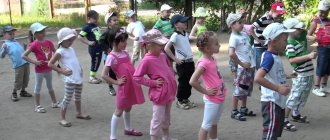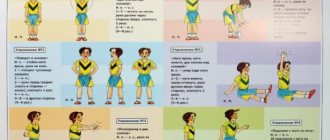Teaching gymnastic tricks
You can learn gymnastic tricks for a child whose physical abilities are good enough for this.
If you send children to professional sports from an early age, the following statistics are observed:
- 1.5-2 years. The child masters the simplest skills that develop his dexterity and the ability to group himself when falling.
- 3 g. The exercises are based on maintaining balance, and also stretch the muscles and develop flexibility.
- 4 g. The trainers gradually introduce the simplest tricks into the program - somersaults, splits, bridges, wheels.
- 5 years. Studying complex coordination movements separately, which will later be assembled into serious tricks.
- 6 years. Exercises on gymnastic apparatus are introduced. Difficult tricks are performed with insurance and under the close supervision of a trainer.
For a child to perform his first difficult trick, he needs to train for 4-4.5 years. The later children come to professional sports, the more difficult it is for them to develop flexibility, agility, and coordination. Therefore, teenagers will need much more time to perform the first trick.
They affect not only their physical fitness and endurance. With the help of training, you can develop discipline, aspirations and desire to work on yourself and your skills.
Features of charging older preschoolers
Older preschoolers already understand the main purpose of exercise, so the teacher’s main attention is paid to the correct execution of exercises and breathing, strict adherence to the rhythm and tempo of the complex, a variety of movements, and careful work with objects.
The introductory part is accompanied by several types of walking and lane changes. Discipline is maintained and the columns are even. Leaders are appointed who must turn from a certain place and lead the children of their team to the construction site. Many children strive to earn the right to be a leader, so they try to perform the exercises well. The teacher sometimes entrusts showing the exercise to the children. At this time, the teacher has the opportunity to walk through the rows, provide individual assistance, correct posture, and check correct breathing.
Systematic performance of morning exercises in the older group develops a habit in children. Children are already more independent.
Preparing to charge
Morning exercises begin with formation in a column. There is a set of exercises without sports equipment, but more often teachers give the children flags or plumes, blocks from a plastic construction set or balls, gymnastic sticks or rattles. The kids are given attributes in advance, and older preschoolers independently take turns sorting the objects from special containers. Sometimes the teacher appoints a person on duty who distributes sports equipment to his comrades.
The cubes can be laid out on the floor so that after the first part of the exercise, children stop near them to perform a set of basic exercises. Before use, the teacher must check the technical condition of the items used so that they are completely safe for children.
Where does charging take place?
In the warm season, morning exercises are carried out outside, on the territory of the group. With older children, jogging is sometimes organized around the kindergarten building or in a designated area. During the cold season, morning exercises are performed in a group or in a gym. If the kindergarten does not have a specially designated room for physical education, then time is allocated for exercise in the assembly hall. Twice a week, many preschool institutions organize morning exercises with musical accompaniment. Rhythmic activities develop a sense of tact and an ear for music.
Preparatory group for school
The set of exercises for children 6–7 years old does not differ much from the previous age group. The teacher already requires clarity and excellent quality of exercises from children. The guys must not only perform the movements, but also know the starting position and intermediate positions. The muscles should feel tense.
Much attention is paid to posture and strengthening the back muscles, because the children will soon go to school and will spend a lot of time at school desks and preparing homework. To avoid curvature of the spine, you need to have strong and developed back muscles.
Children's morning exercises provide a great mood and give a charge of vigor for the whole day, help to liberate shy and indecisive children, and discipline spoiled and overexcited children. During morning exercises, children calm down faster after saying goodbye to their parents and tune in to a certain kindergarten routine.
Contraindications
Gymnastic exercises for children, which need to be performed every morning, have almost no contraindications. If the child feels great and has no problems with joints or blood circulation, then you can safely start exercising, and constantly add new complexes, or increase the duration of old ones.
You should be more careful if you have health problems. Doctors consider the following list of contraindications:
colds, any other temporary infections. While fighting the virus, your body temperature rises. And any physical activity raises it further, which can lead to complications and chronic diseases;
- inflammation. Body temperature rises, and gangrene and purulent infections may develop in areas of inflammation, as a favorable environment for bacterial growth is formed;
- bleeding. Physical exercise accelerates blood circulation, causing the flow to become even stronger;
- blood pressure problems. If they are temporary, then you need to stop morning exercises until recovery. When your blood pressure is constantly abnormal, you should consult your doctor. He will tell you what specific exercises you can do, and they will not harm your health;
- malignant tumors. With such serious diseases, the body should not be given additional stress, since it has to spend a lot of energy to fight the disease.
Physical activity is not recommended during the recovery stages. You need to give your body time to finally get stronger, and only after that resume gymnastics.
Charging components
- Introductory part. First, children walk in a circle, then begin to perform simple movements while walking, for example: walking on their toes with their hands on their belts; walking on your heels with your hands behind your head; walking like a horse with high knees; walking in single file. Next - easy jogging. The introductory part ends with walking and changing lanes. Children of younger groups stop to perform basic exercises in a circle. Children of older groups can form 2 or 3 columns or ranks.
- Main part. General developmental exercises for all muscle groups. Morning exercises begin with training the shoulder girdle, then the muscles of the back and pelvis are involved. Next, exercises are performed for the legs and feet, including squats and jumps.
- Final part. Its goal is to restore breathing. The guys do breathing exercises either on the spot or while walking in a circle.
Eighth complex (age 2-3 years)
- Walking along a stick, rope or along a path whose width ranges from 5-10 cm.
- Reach objects lying on the floor without bending your knees.
- Raise your head and, in a lying position, look at the toy, which is lying on a chair or raised to a height of 25-30 cm.
- Step over pencils, sticks, cubes, which are located at a distance of 20-30 cm from each other.
- Climb through a stick, rope, into a hoop, under a bench or chair, while arching your back.
- Lift a pencil lying on the floor with your toes.
Classes are conducted every other day or daily, about half an hour after breakfast or nap. Classes last 12-15 minutes, the child is dressed in a T-shirt and shorts. All exercises are performed on the mat barefoot, while keeping the window or transom open. For classes you need a jump rope or rope, a hoop (diameter 45-50 cm), a stick (length 1-1.5 m, diameter 2.5 cm), ball, cubes, skittles, and blocks.
Game gymnastics: purpose, objectives, benefits
Play gymnastics is a direction of physical exercises aimed at developing flexibility, dexterity, and motor skills through a light, playful form. It is the best way to attract a child to physical education.
The main advantage of this type of gymnastics is the presence of a game moment. Through games and simple and understandable exercises, the baby trains his body and lifts his mood. Children of toddler and preschool age learn about the world through play, so the use of game elements is an additional motivation to follow their parents.
The goal of play gymnastics is the development of all muscle groups, improvement of the functioning of internal organs and systems, and the formation of strong immunity. In the process of solving the main problem, tasks important for the health and physical development of the child are realized:
- teaching a child to exercise;
- improvement of the musculoskeletal system, posture;
- increasing flexibility and endurance;
- increase in strength;
- improving coordination;
- development of memory and attention.
Additional advantages of play gymnastics can be:
- development of a sense of rhythm, ear for music, improvement of dance skills - when using music as a background to a lesson;
- expanding one's horizons, creative thinking, and ability to express oneself - when submitting exercises along with educational, developmental or educational material (cards, videos, stories, poems, etc.).
Play gymnastics are activities aimed at developing and accustoming a child to physical education through a game, a game plot or a game form.
The exercises offered to the child should be:
- simple and accessible. The baby should repeat the proposed exercise after you the first time, without having to think long;
- match the baby's capabilities. Offer only those tasks that your child can do; avoid difficult tasks if you are not sure that your child can do them;
- varied, often changed. To maintain interest on the part of the child, you need to try to change the exercises before they become boring for the baby. Typically suggest 3 to 7 repetitions;
- not overloading the child’s nervous and muscular energy. After gymnastics, the baby should be cheerful and cheerful, the appearance of fatigue is unacceptable;
- affect different muscle groups. Try to put stress on different parts of the body: arms, legs, abs, back. When drawing up a training program, arrange the order of tasks so that exercises for one muscle group do not go in a row.
To make it interesting for the baby, it is recommended to use various equipment:
- toys;
- sports equipment;
- educational cards;
- video instructions, etc.
It is good to stimulate children to repeat the suggested movements after their parents - the use of various names that are understandable to the child, calling on them to imitate familiar objects or living beings (“we fly like birds”, “jump like frogs”, “stand like a heron”). This approach intrigues children and encourages them to imitate animate and inanimate objects or creatures.
There are several rules that adults need to know:
- use the “mirror method”. If you say that the child needs to raise his right hand, then you raise your left so that the baby mirrors your actions. There is no need to force the child to think again about which arm or leg to move;
- Invite your son or daughter to repeat after you, rather than explain in words. Toddlers and preschool children understand body language better than verbal, even high-quality, instructions;
- Perform the proposed exercises clearly and correctly, so that by imitating you, your baby will immediately learn the correct technique;
- Complete the exercise before it becomes uninteresting for the child.




